What is topiary art and how to make "living" figures with your own hands?
Since ancient times, people have tried to decorate not only their home, but also the area around it. Figures of animals and sculptural compositions are still being made from improvised means. But you can turn your garden into a piece of paradise by cutting trees and shrubs, creating sculptural compositions from plants.
The sophistication of style, its severity, sophistication attracts a modern person to topiary art. The fashion for living figures has returned more than once, since ancient times. The so-called baroque gardens were especially popular during the Renaissance, in the 18th and 19th centuries. The hobby for topiary continues. And now the market offers ready-made live forms grown in special conditions. But they also create topiary on their own.
Content:
- The essence of topiary art
- Types and forms of topiary
- What plants are suitable for creating topiary forms?
- Best ideas for creating green shapes
- Topiary care tips
The essence of topiary art
Topiary is based on the ability of a person to turn an ordinary tree or shrub into a work of garden art. The creation of the figures is carried out taking into account the fantasy design of the designer using scissors, a saw and a rope. From green material, shapes are created, both geometric and people, animals, birds. They will become a decoration of the lawn, resting place. Topiary is often used to create hedge instead of boring fences.
Trees are grown on trellises to form green roofs, under which you can walk or even ride a bike. It is fashionable to use a garden in a landscape - bonsai, as a kind of topiary art. In the topiary, the creation of green arches and gazebos stands apart.
All shapes, shapes are created using haircuts and trimming.
Trees and shrubs are trimmed, creating figures of strict geometric shape, on hedges. Pruning is a more painstaking task that requires a certain skill, with the creation of the shapes of umbrellas, balls, trellises. It is important to choose the right types of plants that match the style of the garden, the selected forms. Anyone who wants to decorate the territory with unusual figures can learn how to create topiary on their site.
Types and forms of topiary
Topiary art works are of several types:
- In a traditional garden, trees are shaped to the desired shape using chalk, rope, and garden shears. Everything is done according to inspiration, according to the way the artist imagines the form of plants necessary to fulfill his plan. To create it, a frame is put on the plant and the crown is trimmed along it.
- Complex compositions are made on the basis of a human or animal figure created from a frame. Frame bases are filled with peat and moss is planted on it. All parts of the figure are firmly attached to each other. As the moss turns green, the figures acquire completeness and expressiveness. They can be decorated with flowers by planting them in peat. Original flowerbeds are obtained, stretching upward. The easiest way is to make shapes from ivy... A plant is woven over the frame made of the frame, bringing life to the landscape design.Such shapes move freely around the site, they are used to create complex compositions.
- For the decoration of the veranda, a topiary in a pot is suitable. A "green" sculpture is formed from a plant planted in a container.
- The bonsai garden comes from Japanese garden art. It focuses on one tree with the original crown.
- For bosquets, closed areas, it is characteristic to define the boundaries with dense plantings of the correct geometric shape.
- An interesting maze with intricate passages of sheared hedges.
Topiary art offers various forms. There is no limit to the imagination of a designer or gardener. One of the most commonly used shapes is the pyramid and ball. They are easy to perform even by novice gardeners. Creating animals and birds requires a certain skill. Here you cannot do without a frame. The same applies to human figures.
In addition to single sculptures, "paintings" composed of several figures are often used, which have a complete plot. The presence of flowers in them revives the topiary figures. Beautiful arched pathways of plants, specially shaped to create the composition. There are simple forms of topiary that a person can build without certain skills, for complex ones, they invite a designer.
What plants are suitable for creating topiary forms
Plants are also selected depending on the shape of the "green" figures:
- The borders of low shrubs are trimmed, and they serve as a border for flower beds, rose gardens, they limit garden paths. Shrubs up to a meter high are necessary for the border, such as boxwood, lavender, rosemary. For boxwood, unpretentiousness is characteristic. It grows well in the sun and in the shade, but for the winter it is covered with spruce branches or special material.
- For hedges along the border of the site, creating a labyrinth is suitable viburnum, euonymus, laurel, privet. Although privet grows quickly, it is a very delicate plant that does not tolerate low temperatures. The same applies to the laurel. It is better to use them for the container type of topiary. If you need a dense high wall, then it is made of thuja, linden, spruce, hornbeam, field maple, hawthorn, yellow acacia. Western thuja is rapidly gaining height as a fast-growing and unpretentious plant. From it you can create any shape for the garden.
- To create an arch, hornbeams or yews are planted opposite each other. The tops of the trees are connected, and by arranging the plantings in a circle, they get a beautiful living gazebo. It is necessary to cut the yew twice a year, as it grows rapidly. The pruning procedure is carried out with gloves due to the poisonous sap of the plant.
- Sculptural compositions need the density of the green mass, therefore, plants with an abundance of foliage and needles are selected. Resistant to any growing conditions barberry, thuja, cotoneaster.
- Not equal to artificial forms with plant crowns, in which it looks like a pyramid (common oak), grows in tiers (controversial dogwood). It looks interesting as a soloist in the garden of the crown of a fan-shaped maple tree. It remains only to correct the shoots by cutting and trimming, giving the crown the desired shape. Of climbing plants, hops are best, grape, ivy. You can also use the loach, picking up varieties according to the color of the flowers.
- For planting in peat embedded in the frames of the figures, ground covers are used. Bryozoans create shapes by placing them in the shadows. The saxifrage is planted in the soil of medium fertility, adding crushed stone, gravel or river coarse sand. It grows up to fifteen to thirty centimeters and does not require abundant watering. Alpine antennae grows rapidly, filling the space of the frame with silvery-green foliage.
Plants are selected in accordance with the concept and style of the topiary.
Best ideas for creating green shapes
It is necessary to start arranging a garden in the form of a topiary with simple figures:
- The geometric shape is made from bushes or trees that are five years old. The dimensions of the crown should be greater than the volume of the intended figure.It is better to cut the branches in early spring before bud break or at the end of summer. Before winter, you should not do a haircut, as the plant will be weakened and may die during the period of severe frosts. Under the crown of the tree, the boundaries of the sides of the cube are marked with sticks. Starting from the upper shoots, with the transition to the side branches, they cut with garden shears. After rough work, the planes are trimmed, removing branches knocking out of the total length. Carrying out the operation, they control, evaluate the actions, moving away to some distance.
- Similarly, the formation of a rounded head of a bush or a pyramidal shearing of tall trees and shrubs is carried out. These shapes will look good in curbs, hedges. Interesting cuboid forms, planted in a checkerboard pattern.
- To create figures of animals, birds or humans, a small-leaved tree or shrub is chosen, tying it to a support. They put a wire mesh on the bush in the form of the conceived sculpture. As the plants grow, they cut off the extra branches. Cut from top to bottom, leaving three buds on the shoots. Instead of pruning, you can guide the branches by tying them to the frame. Additional parts are made from a painted block of wood, attached to a wire to the main structure. The device of such a sculpture or composition will take more than one year. But it will become an original decoration of the lawn, recreation area, the shore of the reservoir.
- You can build "green" furniture with a table, armchairs, a sofa, stuffing the frames with peat and planting moss on it. Before filling, the moss is soaked in water for half an hour. Having filled the structural base with a substrate, plants are planted in the holes made. These include succulents, ground cover, climbing herbaceous species. Grapes, ivy, and loosestrife will do. To fasten the shoots to the wire frame, paper clips are used. The plant grows together with a given shape. It remains then to remove the frame mesh. Figures of hedgehogs, a family of pigs, an elephant are built in a similar way. To make the sculpture look neat, sphagnum moss is chosen low with a bright green color. It is better to collect natural material in a whole layer, gently prying it. After collecting moss in the forest, the bald spots are sprinkled with foliage to quickly restore the integrity of the cover. To save moss, it is mixed with straw and earth.
- To simplify the creation of the "green figure", you can take a child's toy as a basis. It is cut in two and clogged with moss. They offer curly nets and specialty stores. Ivy or hops are good for making shapes quickly. A metal structure of a car, a sofa and other objects is placed on the planted climbing plants. The branches of the plants are fixed with a rope to the net and cut. The frame grows during the summer.
- Figures of moss topiary are installed in the shade of a tree, balcony. The moss will burn out in the sun, and the sculpture will lose its attractiveness.
- A garden of small sculptures made of rosemary, thyme, lavender will look unique. For them, you can choose a spherical shape. It will add completeness and originality to the garden.
- One of the types of topiary is bonsai when decorating a tree in an oriental style. Amenable to haircut, except for privet and elm, Tatar honeysuckle. Common pine or European spruce are chosen from conifers. A selected tree is dug out of the forest and transferred to the garden. First, it is placed in a corner protected from the wind, with enough light, and then transplanted to a permanent place. Best of all, a bonsai tree will decorate an alpine slide, the shore of a reservoir or a flower bed.
They work on the formation of the crown using garden tools. Some of the branches are cut off, leaving them horizontal. To give direction to the skeletal branches, they are tied to the slats, hanging weights to pull them down. You can wire the shoots to the desired shape. During the growth of the tree, it is controlled that the wire does not interfere with the movement of the sap inside the tree.During the season, to maintain shape, unnecessary processes are removed, and the trunk is cleaned of awakening buds.
For conifers, the technique of plucking young branches is used, breaking them off by hand. The tops of the trees are removed to stimulate the formation of new shoots. Place trees in a bonsai garden in sunny areas. All topiary ideas are interesting in their own way, you just need to choose what is suitable for the site in accordance with the style of the territory.
Topiary care tips
The rules for caring for topiary are as common as for garden plants:
- Water the figures abundantly so that the plants do not turn yellow. Drought is dangerous for sphagnum moss... It is constantly sprayed from above. For large figures, they arrange drip irrigation or build a special irrigation system.
- Cutting and trimming the figures is done regularly, otherwise they will look sloppy. Be sure to leave several buds on the branches for the further vegetation of the plant. Garden shears or pruning shears are used for the procedure, which are disinfected in advance. The operation is performed with gloves.
- For plants that do not tolerate frost well and may die, container forms are chosen. In the fall, the pots with figures are removed to a room with an air temperature of at least five degrees Celsius. If it is not possible to remove living sculptures, then they are carefully covered with protective material or fallen leaves, covered with snow.
- It is possible not to remove the metal mesh from the frame figures, having previously painted it green so that it does not stand out in color from the material of the sculpture. Indeed, sometimes when the frame is removed, the crown is damaged.
- Trees in the topiary definitely need feeding mineral and organic fertilizers... In the summer, they are brought in two or three times with an interval of two weeks.
- For coniferous bonsai trees, restrict root growth. A large stone is buried to a depth of forty centimeters, and a tree is placed in this place. Once every two years, spruce or pine is cut off the lateral rhizomes.
- To care for the figures, weeding, elimination of pests, and infection control are needed. This happens according to the usual scheme with the use of folk and chemical preparations.
Topiary figures will last for a long time, they will look beautiful with proper care.
More information can be found in the video:




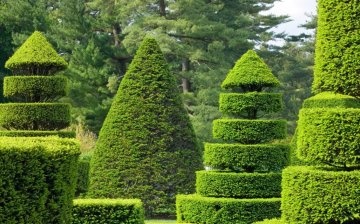
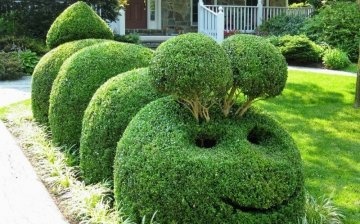
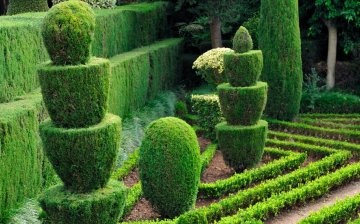
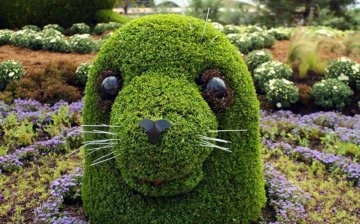








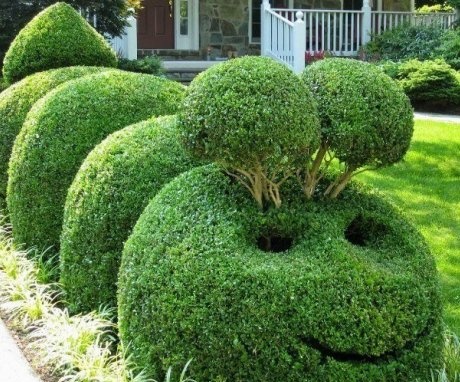

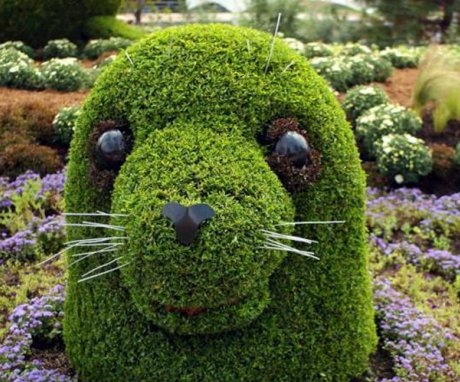

I really like topiary figures, they decorate any space like that. Especially if these figures are made neatly and unusually, the same animals, for example :) And apparently it was not in vain that I compared them with bonsai))
We specially bought one plant for the dacha to try. We even bought a battery-powered pruning and cutting tool. But we can't do anything !!! Apparently the hands do not grow from there)
So far, I only manage to make rounded shapes, but I try to gradually complicate the shapes. I will definitely take note of the recommendations from the article, the information is really very useful and will greatly facilitate the work.
Dear AnnaAlimova! We also started with rounded shapes and are very satisfied with the result of our work. As soon as you learn how to make a round ball from a bush, try moving to a square! We have begun.
This is a serious and professional work, and not every person can do it. I don't have such beauty at home, of course, but the dacha is mostly planted not with trees and shrubs, but with potatoes and tomatoes.